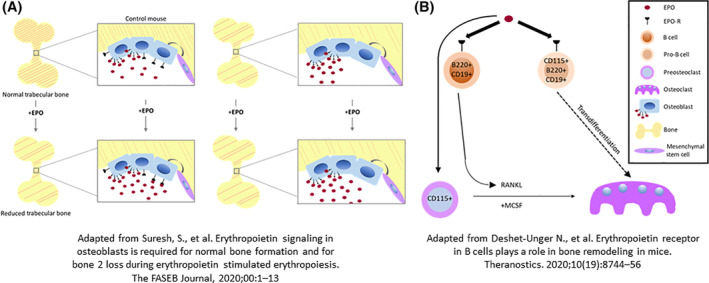FIGURE 1.

The role of Epo‐Epor signaling in bone development and remodeling. A, Epor expression in osteoblasts is required for bone loss in EPO‐stimulated erythropoiesis. In addition to its cardinal effect of enhancing erythropoiesis, recombinant human erythropoietin (EPO) has nonerythroid effects that include a reduction of bone mass in patients undergoing treatment for anemia. Osteoblasts synthesize bone, express functional Epor, and also produce Epo. Suresh et al found that EPO directly stimulates osteoblasts to decrease bone mass. Transgenic mice (Tg) with osteoblastic‐specific deletion of Epor exhibit reduced bone. EPO administration (1200 U/kg) for 10 days reduced trabecular bone in control mice, but not in Tg mice. B, Epor expression in B cells contributes to osteoclastogenesis and bone remodeling. In common with osteoblasts, osteoclasts, preosteoclasts, and some B and Pro‐B cells express functional Epor. Deshet‐Unger et al present evidence for an alternative B cell‐derived osteoclastogenic pathway in which EPO treatment increased the osteoclastic factor RANKL, induced Pro‐B cell transdifferentiation to osteoclasts, and increased the number of B cell‐derived preosteoclasts. Mice with conditional knockdown in the B cell lineage displayed higher cortical and trabecular bone loss
